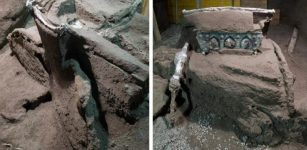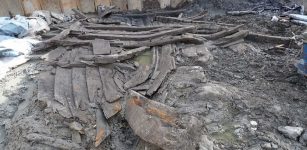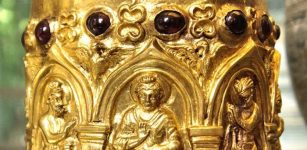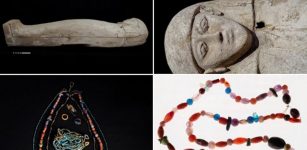Yuezhi Civilization: Ancient Nomadic People Who Once Ruled Bactria
Ellen Lloyd - AncientPages.com - The first mention of the Yuezhi civilization can be found in ancient Chinese sources from the 2nd century B.C.
They are describes as nomadic people living in the western part of Gansu province, northwestern China. Known by a Chinese name (“Meat Eaters,” a Chinese appellation), the Yuezhi was one of the numerous Iranian or Aryan nomadic tribes.
The Yuezhi - first mentioned in ancient Chinese sources at the beginning of the 2nd century B.C are generally believed to have spoken a language related to Tocharian, of the Indo- European family, and to have been ethnically Caucasoid.
Before being driven out by the Xiongnu, a powerful people of North China, the Yuezhi dominated the northern steppes, still searching for new territories. Finally they moved westward into Sogdiana and Bactria, where they put an end to Greek rule in both regions.
Ancient Bactria was located between the Hindu Kush mountain range and the Amu Darya river, covering the flat region that we today recognize as modern-day Afghanistan and Tajikistan. Bactria was the birthplace of Zoroastrianism, and later also hosted Buddhism before becoming Muslim.

Bust of a man, found at from Khalchayan, a major site of the Yuezhi (later Kushan) people, in Bactria (modern Surxondaryo Province, Uzbekistan). Painted clay.Image credit Wikipedia
The Yuezhi were involved in many conflicts. They fought the Tocharians, Scythians, and even the Han Empire in Central Asia.
When the Yuezhi entered Bactria, they defeated the Greco-Bactrian kingdom, forcing them to regroup in India. They also displaced a people called the Saka, who responded by overrunning portions of the Parthian Empire.
Tribes of Scythians and Saka eventually established themselves all over Afghanistan.
See also:
Lost Ancient Greco-Bactrian Kingdom Of 1,000 Cities
Mysterious Disappearance Of Scythians Remains Unsolved
Ancient Great City Of Napata In The Kingdom Of Kush
In time, the Yuezhi consolidated and established an agricultural economy. A new dynasty, known as the Kushan, was subsequently founded by one of the five chieftains among whom Bactria was divided. The Kushan kingdom was powerful and extended its power and their territories southward, eastward into India, and northward into Central Asia.
The Kushans managed to survive for three centuries, until forces from Persia, Pakistan, and India all re-conquered their old territories. In consequence, the Kushan Kingdom's power declined.
Missionaries from the Great Yuezhi played an important part in spreading and promoting of Buddhism in China. The spread of Indian culture into the territories of Central Asia reaching the borders of China probably resulted from Kushan influence.
Written by - Ellen Lloyd – AncientPages.com
Copyright © AncientPages.com All rights reserved. This material may not be published, broadcast, rewritten or redistributed in whole or part without the express written permission of AncientPages.com
More From Ancient Pages
-
 Incredible Ancient Star Map Depicting Our Galaxy Is Hidden In Africa
Ancient Mysteries | Aug 4, 2018
Incredible Ancient Star Map Depicting Our Galaxy Is Hidden In Africa
Ancient Mysteries | Aug 4, 2018 -
 Mysterious Unknown Strange-Looking Ancient Seafarers – Survivors Of A Now Vanished Race?
Ancient Mysteries | Oct 11, 2022
Mysterious Unknown Strange-Looking Ancient Seafarers – Survivors Of A Now Vanished Race?
Ancient Mysteries | Oct 11, 2022 -
 Anomalous Ancient Structures In The South West Pacific Remain Unexplained
Ancient Mysteries | May 19, 2018
Anomalous Ancient Structures In The South West Pacific Remain Unexplained
Ancient Mysteries | May 19, 2018 -
 On This Day In History: ‘Principia Mathematica’ Monumental Work Published By Isaac Newton – On July 5, 1687
News | Jul 5, 2016
On This Day In History: ‘Principia Mathematica’ Monumental Work Published By Isaac Newton – On July 5, 1687
News | Jul 5, 2016 -
 Mysterious Viking Burial Site Of Three Women In Norway Reveals Its Secrets
Vikings | Dec 26, 2024
Mysterious Viking Burial Site Of Three Women In Norway Reveals Its Secrets
Vikings | Dec 26, 2024 -
 Controversial 5,500-Year-Old Sumerian Star Map Of Ancient Nineveh Reveals Observation Of Köfels’ Impact Event
Artifacts | Dec 28, 2018
Controversial 5,500-Year-Old Sumerian Star Map Of Ancient Nineveh Reveals Observation Of Köfels’ Impact Event
Artifacts | Dec 28, 2018 -
 Forgotten Ancient Empire That Extended Far Beyond America To Iceland And Its Mysterious Inscriptions
Ancient Mysteries | May 6, 2021
Forgotten Ancient Empire That Extended Far Beyond America To Iceland And Its Mysterious Inscriptions
Ancient Mysteries | May 6, 2021 -
 The Bushido Code: Centuries-Old Unwritten Code For Ideal Samurai Warrior
Featured Stories | Dec 26, 2016
The Bushido Code: Centuries-Old Unwritten Code For Ideal Samurai Warrior
Featured Stories | Dec 26, 2016 -
 Extraordinary Ancient Roman Ceremonial Chariot Discovered In Pompeii – It’s Still Almost Intact
Archaeology | Mar 1, 2021
Extraordinary Ancient Roman Ceremonial Chariot Discovered In Pompeii – It’s Still Almost Intact
Archaeology | Mar 1, 2021 -
 Viking House The Size Of Two Tennis Courts Discovered In Norway
Archaeology | Jul 20, 2023
Viking House The Size Of Two Tennis Courts Discovered In Norway
Archaeology | Jul 20, 2023 -
 Three 17th Century Shipwrecks Discovered In Central Gothenburg, Sweden
Archaeology | Oct 8, 2019
Three 17th Century Shipwrecks Discovered In Central Gothenburg, Sweden
Archaeology | Oct 8, 2019 -
 Mysterious Mummified Woman With A Christian Cross On Her Chest Dashes Hopes Of Finding First Russian Fortress In Yakutia
Archaeology | Dec 12, 2019
Mysterious Mummified Woman With A Christian Cross On Her Chest Dashes Hopes Of Finding First Russian Fortress In Yakutia
Archaeology | Dec 12, 2019 -
 Strange 1,000-Year-Old Artifact Melted Out Of The Ice Identified With Help Of Photo!
Archaeology | Jan 31, 2023
Strange 1,000-Year-Old Artifact Melted Out Of The Ice Identified With Help Of Photo!
Archaeology | Jan 31, 2023 -
 The Bimaran Casket – Rare Golden Artifact Found In Ancient Stupa
Artifacts | Dec 17, 2018
The Bimaran Casket – Rare Golden Artifact Found In Ancient Stupa
Artifacts | Dec 17, 2018 -
 Young Boy Finds Baffling Artifacts In New Mexico Predating The Anasazi, The ‘Ancient Ones’
Featured Stories | Aug 6, 2024
Young Boy Finds Baffling Artifacts In New Mexico Predating The Anasazi, The ‘Ancient Ones’
Featured Stories | Aug 6, 2024 -
 Ancient DNA Reveals Missing Link In The History Of Indo-European Languages
Linguistic Discoveries | Feb 5, 2025
Ancient DNA Reveals Missing Link In The History Of Indo-European Languages
Linguistic Discoveries | Feb 5, 2025 -
 Mysterious Disappearance of Scythians Still Remains Unsolved
Civilizations | Sep 6, 2015
Mysterious Disappearance of Scythians Still Remains Unsolved
Civilizations | Sep 6, 2015 -
 Evidence Of Rare Roman-Celtic Temple Near Lancaster Castle
Archaeology | Mar 9, 2023
Evidence Of Rare Roman-Celtic Temple Near Lancaster Castle
Archaeology | Mar 9, 2023 -
 Beautiful Necklaces And Amulets Discovered In Ancient Egyptian Tomb
Archaeology | Apr 27, 2020
Beautiful Necklaces And Amulets Discovered In Ancient Egyptian Tomb
Archaeology | Apr 27, 2020 -
 Unique Viking Age Arm Ring Found On Öland And Stunning 2,000-Year-Old Gold Torc Discovered In Trollhättan, Sweden
Archaeology | Mar 19, 2025
Unique Viking Age Arm Ring Found On Öland And Stunning 2,000-Year-Old Gold Torc Discovered In Trollhättan, Sweden
Archaeology | Mar 19, 2025


